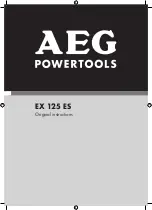
4
PERSONAL SAFETY
●
Stay alert, watch what you are doing
and use common sense when
operating a power tool. Do not use
the tool while tired or under the
influence of drugs, alcohol or
medication.
A moment of inattention
while operating power tools may result
in serious personal injury.
●
Dress properly. Do not wear loose
clothing or jewellery. Contain long
hair. Keep your hair, clothing and
gloves away from moving parts.
Loose clothing, jewellery or long hair
can be caught in moving parts.
●
Avoid accidental starting. Be sure
power switch is OFF before
plugging in.
Carrying tools with your
finger on the switch or plugging in tools
that have the switch ON invites
accidents.
●
Remove adjusting keys or wrenches
before turning the tool ON.
A wrench
or key that is left attached to a rotating
or moving part of the tool may result in
personal injury.
●
Do not overreach. Keep proper
footing and balance at all times.
Proper footing and balance enables
better control of the tool in unexpected
situations.
●
Use safety equipment. Always wear
eye protection.
Dust mask, non-skid
safety shoes, hard hat and/or
hearing protection must be used in
appropriate conditions.
TOOL USE AND CARE
●
Use clamps or another practical
method to secure and support the
workpiece on a stable platform.
Holding the work by hand or against
your body is unstable, unsafe, and
may lead to loss of control.
●
Do not force the tool. Use the
correct tool for your application.
The correct tool will do the job better
and safer at the rate for which it is
designed.
●
Do not use the tool if the power
switch does not turn it ON or OFF.
Any tool that cannot be controlled with
the switch is dangerous and must be
repaired.
●
Disconnect the plug from the power
source before making any
adjustments, changing accessories
or storing the tool.
Such preventative
safety measures reduce the risk of the
tool starting accidentally.
●
Store idle tools out of reach of
children and other untrained
persons.
Tools are dangerous in the
hands of untrained users.
●
Maintain tools with care. Keep
cutting tools sharp and clean.
Properly maintained cutting tools with
sharp cutting edges are less likely to
bind and are easier to control.
SAVE THESE INSTRUCTIONS FOR REFERENCE
POWER TOOL SAFETY





































